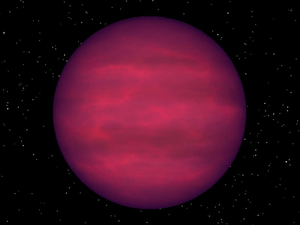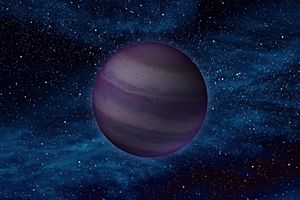Brown dwarf facts for kids
A brown dwarf is a space object that's kind of like a star, but not quite. It's also a bit like a giant planet, but not quite that either! Think of it as something in between a very small star and a very large planet.
Brown dwarfs are made of the same stuff as stars, like hydrogen and helium. Stars shine brightly because they have a lot of mass, which creates huge pressure and heat in their core. This causes a process called nuclear fusion, where hydrogen atoms combine to make helium, releasing a lot of energy and light.
Brown dwarfs don't have enough mass to start this powerful hydrogen fusion. So, they don't glow like regular stars. But they are different from giant planets because they do glow a little bit, mostly from the heat left over from when they formed.
Their size is usually between 13 and 80 times the mass of Jupiter. Brown dwarfs that are heavier than 13 times Jupiter's mass can fuse a special type of hydrogen called deuterium. If they are heavier than about 65 times Jupiter's mass, they can also fuse lithium.
Even though they are called "brown dwarfs," most of them would actually look magenta (a purplish-red color) to our eyes! The closest known brown dwarf system is called WISE 1049-5319, which is about 6.5 light-years away from Earth. It's actually a pair of brown dwarfs orbiting each other.
Contents
Discovering Brown Dwarfs
Scientists first started talking about objects like brown dwarfs in the 1960s. They even had other names for them, like "planetar" or "substar." For many years, these objects were just ideas, and no one had actually seen one.
It was thought that objects less than about 9% of our Sun's mass would never become normal stars. But it was very hard to find these objects because they don't give off much visible light. They mostly shine in infrared light, which our eyes can't see. Back then, the tools to detect infrared light weren't very good.
In 1988, scientists found an object called GD 165B. It didn't look like a small red star, which was exciting! Today, GD 165B is known as the first example of a group of objects called "L dwarfs." Even though it was a big discovery, scientists weren't sure if it was a brown dwarf or just a very small star. It was hard to tell the difference just by looking at its light.
The Lithium Test
Soon after GD 165B, other possible brown dwarfs were found. But many of them turned out to be small stars instead. This is where a clever test comes in: the "lithium test."
Real stars burn up their lithium in about 100 million years. Brown dwarfs, however, don't get hot enough to do this, so they keep their lithium. This means if an object is older than 100 million years and still has lithium in its atmosphere, it's very likely a brown dwarf!
First Confirmed Brown Dwarfs
The study of brown dwarfs changed a lot in 1994 and 1995 with the discovery of two objects that were definitely not stars: Teide 1 and Gliese 229B.
The first truly confirmed brown dwarf was found in 1994. It was named Teide 1 and was located in a group of young stars called the Pleiades cluster. Scientists knew its age and what it was made of because it was part of this cluster. Teide 1 has a mass about 55 times that of Jupiter, which is clearly too small to be a regular star.
Even more amazing was Gliese 229B. It was found to be much cooler and dimmer than any star. What made it special was that its light showed clear signs of methane gas. Methane had only been seen in the atmospheres of giant planets like Saturn and its moon Titan. This discovery helped create a new group of even cooler brown dwarfs called "T dwarfs," and Gliese 229B is the first example of this type.
Scientists looked at Teide 1's light very carefully and found that it still had all its original lithium. This proved that it had never started nuclear fusion in its core, confirming it was indeed a brown dwarf.
For a while, Teide 1 was the smallest object found outside our Solar System by direct observation. Since then, over 1,800 brown dwarfs have been identified! Some are quite close to Earth, like a pair of brown dwarfs called Epsilon Indi Ba and Bb, which orbit a star similar to our Sun about 12 light-years away. And, as mentioned, WISE 1049-5319 is only about 6.5 light-years away.
What's the Difference?
For some years, scientists have been discussing how to clearly tell the difference between a very small brown dwarf and a very large giant planet. The main debate is whether to define them by how they form, or by what's happening inside them. This is still an active area of research!
Images for kids
-
Chandra image of LP 944-20 before and during a flare.
-
Pictures taken over time by the Hubble Space Telescope showing pairs of brown dwarfs. The pair Luhman 16 AB (left) is closer to our Solar System than the others.
See also
 In Spanish: Enana marrón para niños
In Spanish: Enana marrón para niños
















